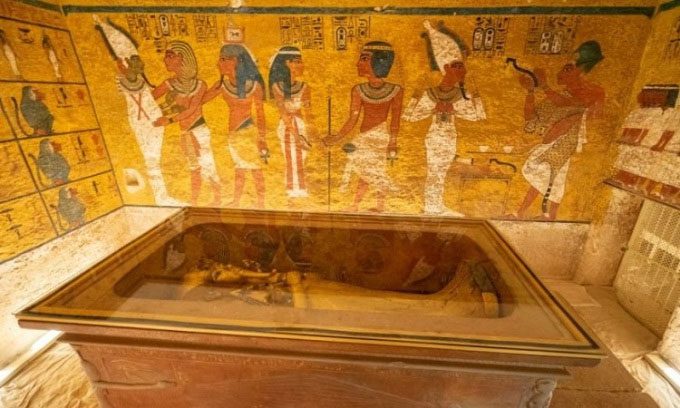The tombs of early Egyptian pharaohs often contained simpler burial goods compared to later periods due to the customs of each era.
When the British archaeologist Howard Carter opened the tomb of King Tutankhamun in 1922, he discovered a treasure trove that included a golden mask, a throne, and even a pair of golden sandals. However, not all royal tombs in ancient Egypt contained luxurious burial items. While the Great Pyramid of Giza and many other Egyptian pyramids are incredibly magnificent, the burial goods inside are relatively simple compared to those found in the tomb of later pharaohs like Tutankhamun.

The tomb of Pharaoh Tutankhamun in the Valley of the Kings. (Photo: skaman306)
“The burial goods in the largest pyramids may seem quite simple compared to those of Tutankhamun,” said Wolfram Grajetzki, a research fellow at University College London and an expert on ancient Egyptian burial customs.
Pyramids were used as tombs for Egyptian pharaohs from the time of Pharaoh Djoser (reigned from 2630 to 2611 BCE) until Ahmose I (reigned from 1550 to 1525 BCE). Most pyramids were looted decades ago, but a few royal tombs remain relatively intact, according to Grajetzki.
For instance, Princess Neferuptah (who lived around 1800 BCE) was buried in a pyramid at the Hawara site, located 100 km south of Cairo. Researchers excavated her burial chamber in 1956 and found pottery, a sarcophagus, some gilded decorations, and numerous royal insignia that helped identify the tomb’s owner.
King Hor (who lived around 1750 BCE) was buried with a similar set of items, although his remains were not placed within a pyramid. The body of King Hor was wrapped in linen, with his internal organs stored in a jar. His face was covered with a mummy mask.
The tomb of Queen Hetepheres, mother of Pharaoh Khufu (the builder of the Great Pyramid), contained more exquisite artifacts. Located in Giza, the tomb included a bed, two gold-decorated chairs, along with pottery and small bronze tools.
The unfinished burial chamber beneath the pyramid of Pharaoh Sekhemkhet (2611 – 2605 BCE) at Saqqara has not been disturbed by tomb robbers, according to Egyptologist Reg Clark. The king’s sarcophagus was empty, but the archaeological team found 21 gold bracelets, a scepter, and many other gold ornaments in a corridor. While these items are highly valuable, they cannot compare to the wealth found in the tomb of Pharaoh Tutankhamun.
Unlike earlier pharaohs, the tomb of Pharaoh Tutankhamun is located in the Valley of the Kings, a secluded valley near modern-day Luxor, which served as a royal cemetery for over 500 years during the New Kingdom. “This does not mean that Pharaoh Khufu was poorer than Tutankhamun. The pyramid of Khufu shows the opposite. Each pharaoh was buried according to the customs of their time.“ Grajetzki explained.
During the New Kingdom, if possible, Egyptians often sought to place a large quantity of decorations in the tomb. Researchers are unclear as to why they did this. Although containing fewer burial goods than later tombs, some pyramids feature hieroglyphics on the walls that record certain spells and rituals, allowing the two parts of the soul separated from the deceased’s body to reunite and help them exist in the afterlife.




















































